The Apparition of Our Lady at Pontmain
1870, Pontmain, France
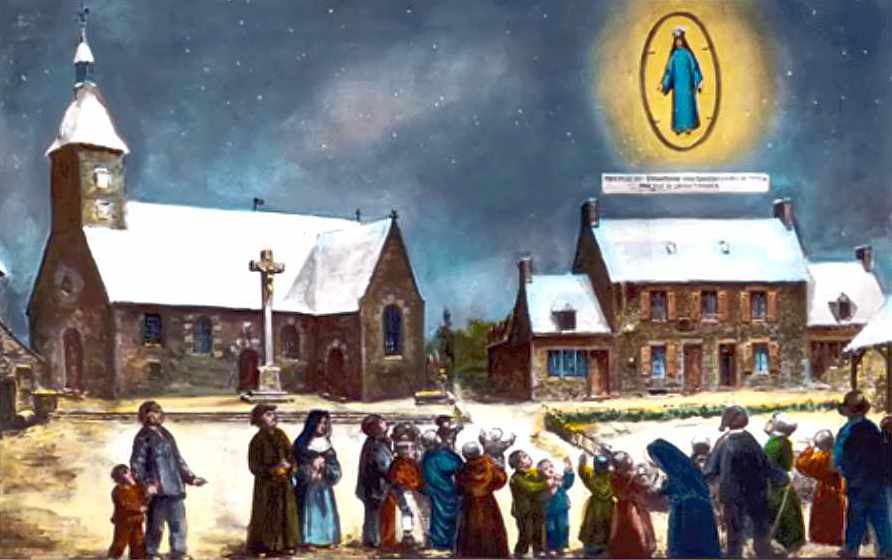
On July 19, 1870, Emperor Napoleon III of France declared war against Prussia. From the first days of the war, defeat followed defeat. By January 1871, Paris was under siege, two-thirds of the country was in the power of the Prussians, and they were advancing towards the west of France. By January 17, 1871, the Prussians were just across the river from Laval, which is the city next to Mayenne.
Towards the evening of January 17, Pontmain, a small town in the north of Mayenne, lay under a blanket of snow. Though the roar of cannon could be heard, the Barbedette family was busy with their household chores before supper. In a barn in the middle of town two boys, Eugene, 12, and Joseph, 10, Barbedette, are helping their father feed the horses. Some minutes before six o’clock in the evening, taking advantage of a break from work, Eugene leaves the barn and sees in the sky a “Lady”. She spreads her lowered hands in a gesture of welcome and smiles on him.

Our Lady of Pontmain, 4 Phases of the Apparition
Joseph comes along a few moments later and also sees the Lady. But the parents of the boys see nothing. The Sisters of the school are called. Again, they see nothing. But two little girls with them, Frances Richer, 11, Jeanne Marie Lebosse, 9, do see the beautiful Lady.
The Lady, as described by Eugene, was dressed in a flowing robe of deep radiant blue studded with gold stars. The sleeves were full, extending up to the hands. She was wearing blue slippers, tied with golden ribbon in the shape of a rosette. Her hair was completely covered with a black veil thrown over her shoulders reaching down to the level of her elbow. On her head, a gold crown rose slightly to a peak. It had no ornament in front except a red band circling the centre. Her hands were extended — “like the Miraculous Medal”, but without the rays of light.
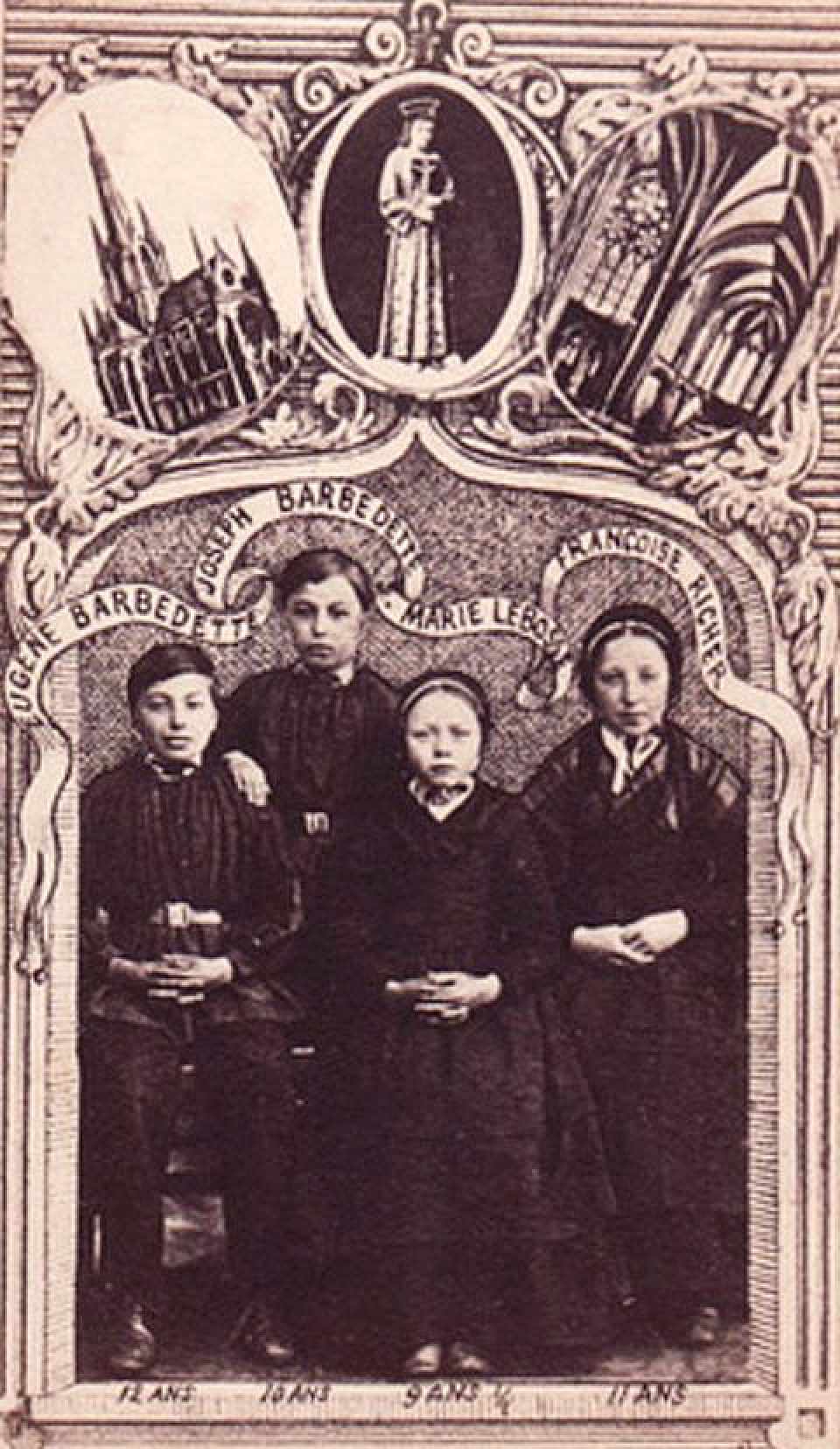
The Visionary Children of Pontmain
From time to time the Lady would look sad because of some haughty and rowdy people in the crowd, but she would smile back, especially with the prayers and hymns, the Rosary and Marian songs of the people led by the parish priest, Father Guerin, and the two sisters. As the congregation was reciting the Rosary, stars gathered two by two, below the Lady’s feet as if representing the Hail Marys of the Rosary. Then a white banner, about a yard wide, unrolled beneath the Lady’s feet, thus forming a perfect rectangle. Here she spelled her message:
BUT PRAY MY CHILDREN GOD WILL ANSWER SOON
MY SON LET HIMSELF BE MOVED
After some time, she raised her hands to the height of her shoulder, arms out and bent slightly backwards and elbows close to her body. Then a large red cross appeared in the hands of the Blessed Virgin. The figure of the crucified Christ was a darker red hue but no blood was flowing from the wounds. The community prayed their night prayers together. A large white veil began to cover the figure of the Virgin, slowly rising to her face and then she gave her last smile to the children. As the night prayers came to a close, the Apparition ended. It was about nine o’clock. The Apparition ended after lasting about three hours.
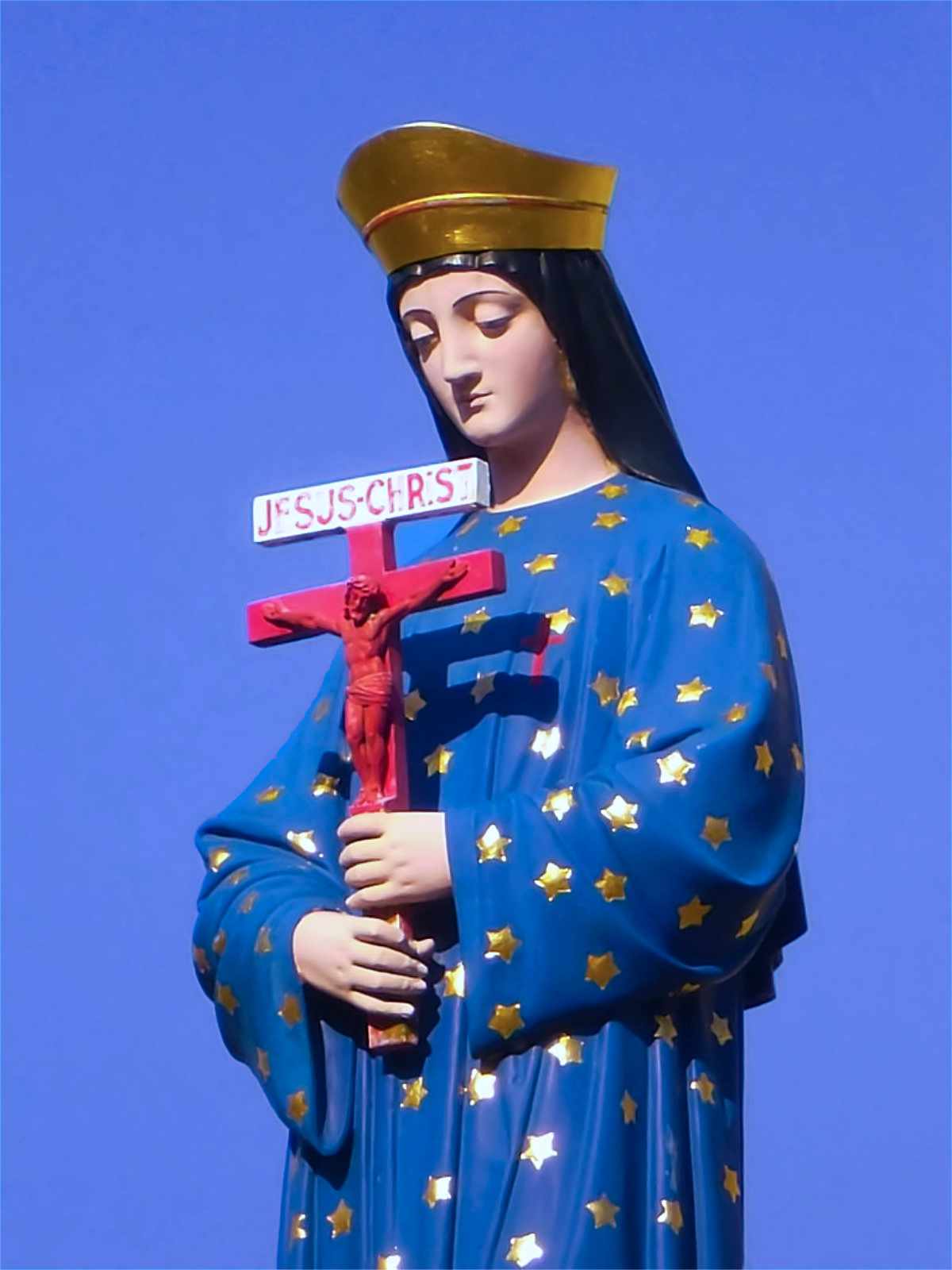
Our Lady of PontmainIn the meantime, late that night of January 17, General Von Schmidt of the Prussian Army who was about to run over Laval towards Pontmain, received orders from his Commander not to take the city. The invasion of the Catholic West never came off. On January 23, 1871, the long-hoped for Armistice was signed. The promise, “God will soon grant your request” of Our Lady of Hope, had been fulfilled. Soon all the thirty-eight conscripted men and boys of Pontmain returned home unscathed. General Schmidt is reported to have said on the morning of the 18th: “We cannot go farther. Yonder, in the direction of Brittany, there is an invisible ‘Madonna’ barring the way.”
On the Feast of the Purification, February 2, 1872, the Most Rev. Wicart, Bishop of Laval, issued a pastoral letter giving a canonical judgment on the Apparition. Thus, the veneration of Our Lady of Hope of Pontmain was given official Church recognition and approval. A basilica was built and consecrated on October 15, 1900.
The Five Phases of the Apparition
First Phase
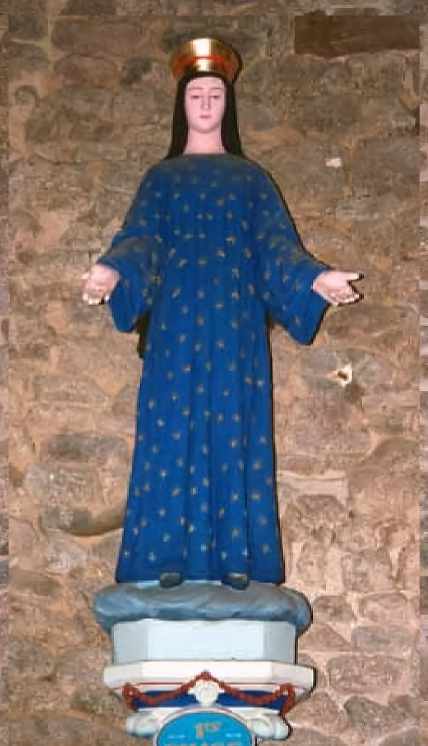
The first of the children to see the royal Lady was Eugène Barbedette. The Lady wore a blue dress decorated with stars, very simple shoes with golden buckle, a gold crown on a black veil covering her hair and half forehead down on his shoulders.
The Lady smiled at the child, as at the little brother Joseph who arrived shortly after. The children ran to tell what they saw to both to their dad and mom Victoire, who start to understand it was about the Virgin Mary, ran to find Sister Vitaline at the parish school to tell her what her children said they were seeing.
Another sister, Marie Edouarde, quickly informed the parish priest, Father Michel Guerin. Meanwhile the entire village had come to the barn and they all began to pray guided by Sister Vitaline.
Second Phase
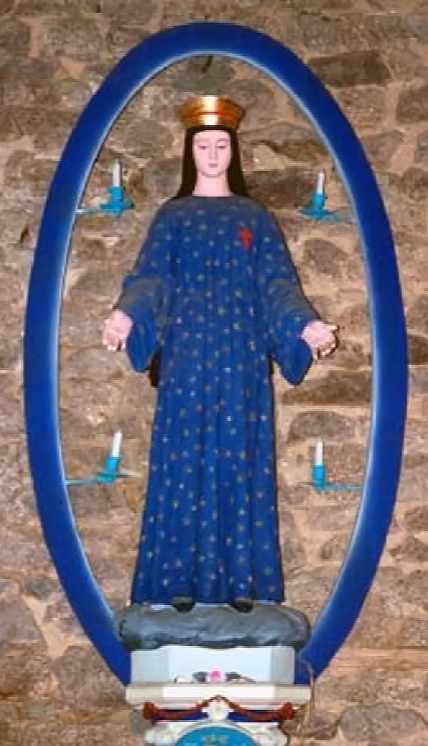
Shortly, as the priest reached his people at the place, a blue oval with four unlit candles appeared around the beautiful Lady, while a small red cross became visible on her dress, at the level of Her heart.
At that moment she became sad. Meanwhile, the crowd began to discuss what was happening while the uproar grew, then the pastor asked everyone to pray, and Sister Marie Edouarde began to pray the Holy Rosary.
So the Lady start to smile and as soon as the prayer became more fervent She began to increase in size; Also the oval around Her grew and the stars, multiplying in number, went to rest at Her feet.
Once the Rosary ended the crowd sang the Magnificat, and at that moment a large white strip unrolled at the feet of the Lady and letter after letter, words appeared: “But pray my children.”
At the invitation of the priest all prayed the Marian Litanies and the sentence on one line got completed: “God will answer shortly.” Then he intoned the Inviolata, and the invocation “O alma Mater Christi dearest” two terms appeared at the beginning of the second line: “My Son …”
And when the crowd prayed the Salve Regina, the written message continued with “… will allow himself to be moved”. Finally, the large group continued to pray silently. Everyone, from the beginning of the sentence – “My Son” – understood to be indeed the Virgin Mary.
Third Phase
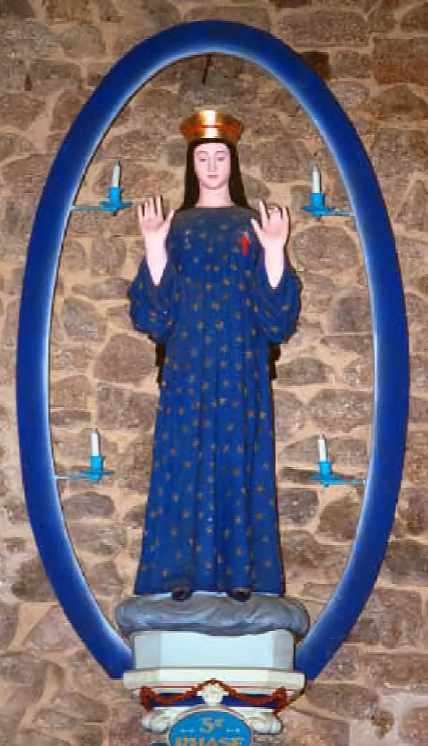
The people gathered there, then, continued with the song “Mother of Hope”, and at this point the Virgin raised Her hands at shoulder level, moving Her fingers to the rhythm of the song, as if to pluck an invisible harp. The joy of children erupted, ripping them over and over again the cry: “O how beautiful She is!”, While Maria was smiling at them.
Then the two sentences on the strip slowly disappeared, making the message fade away too and giving way to a background color similar to the night sky. Children started another singing, the one they had performed at school in the afternoon; in that very moment Mary’s face showed great sadness.
Fourth Phase
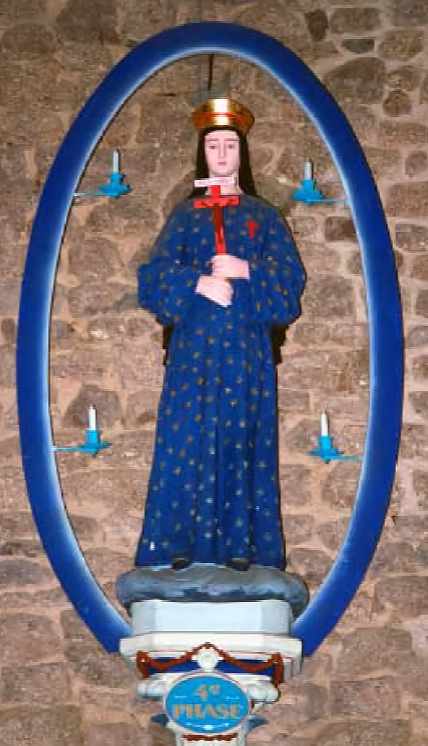
As soon they began to sing, before the Virgin a 50 cm red cross appeared with right above a white scroll with the words “Jesus Christ.” The Lord appeared bloodied. Singing the Parce Domine the Virgin Mary took the cross with both hands and leaned it toward the children, who warned everyone that She was becoming sad again.
Then, a small star lit the four candles inside the oval, just as the same as the priest used to do at the altar of the Virgin in the parish church. The crowd continued to pray in silence, and the star went to position itself above the head of the Lady.
Fifth Phase
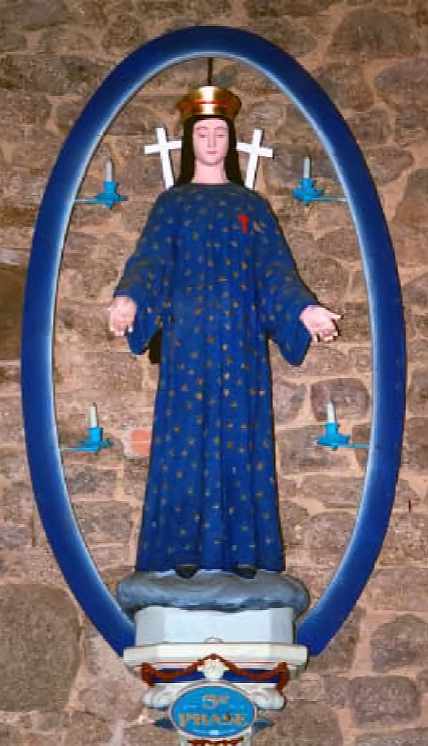
Finally, Sister Marie Edouarde prayed the Ave Maris Stella and the red crucifix disappeared, but appeared at the same time, two other small white crosses on each shoulder of the Lady who start to smile again.
The priest invited those present there to pray with him the prayers of the evening and everyone knelt. At the examination of the conscience, a white veil lifted slowly from the Virgin’s feet making Her disappear gradually from the sight of the children.
The vision finally ended at around nine o’clock in the evening. All then returned to their homes.
The Secret of Pontmain
by Louis d’Alencourt
This article proposes to revisit the apparition of Pontmain from a new angle, highlighting what would be, according to my interpretation, its eschatological significance.
Like any apparition of the Blessed Virgin, there is an immediate message, which concerns the period of the apparition (in this case the war of 1870 between Prussia and France), and a message with a longer range which will apply to the last times of the world.
An appearance of 3 and a half hours
The first point is the duration of the apparition: it lasts from 5:30 pm to almost 9 pm: almost three and a half hours, but not quite.
We should already know that 3 and a half corresponds to a recurring time in the Bible, expressed in different ways: one time, two times, half a time, or three and a half days, or three and a half years, or 42 months, or 1260 days: it is always the same notion of duration that is expressed by this "3 and a half".
Now this is exactly what Pontmain expresses: a little less than 3 hours and a half.
We find this duration in "3 and a half" at key moments of the holy history: it is about the duration of the public life of Christ (a little less than 3 years and a half), it is also the duration of the life of the beast of the Apocalypse, 3 years and a half, or 42 months, time which will be shortened promised to us by Jesus in Matthew 24.
There is therefore a first link, by this duration, with the end of time, and mainly with the hardest period of tribulations, that of the reign of the beast, therefore of the Antichrist.
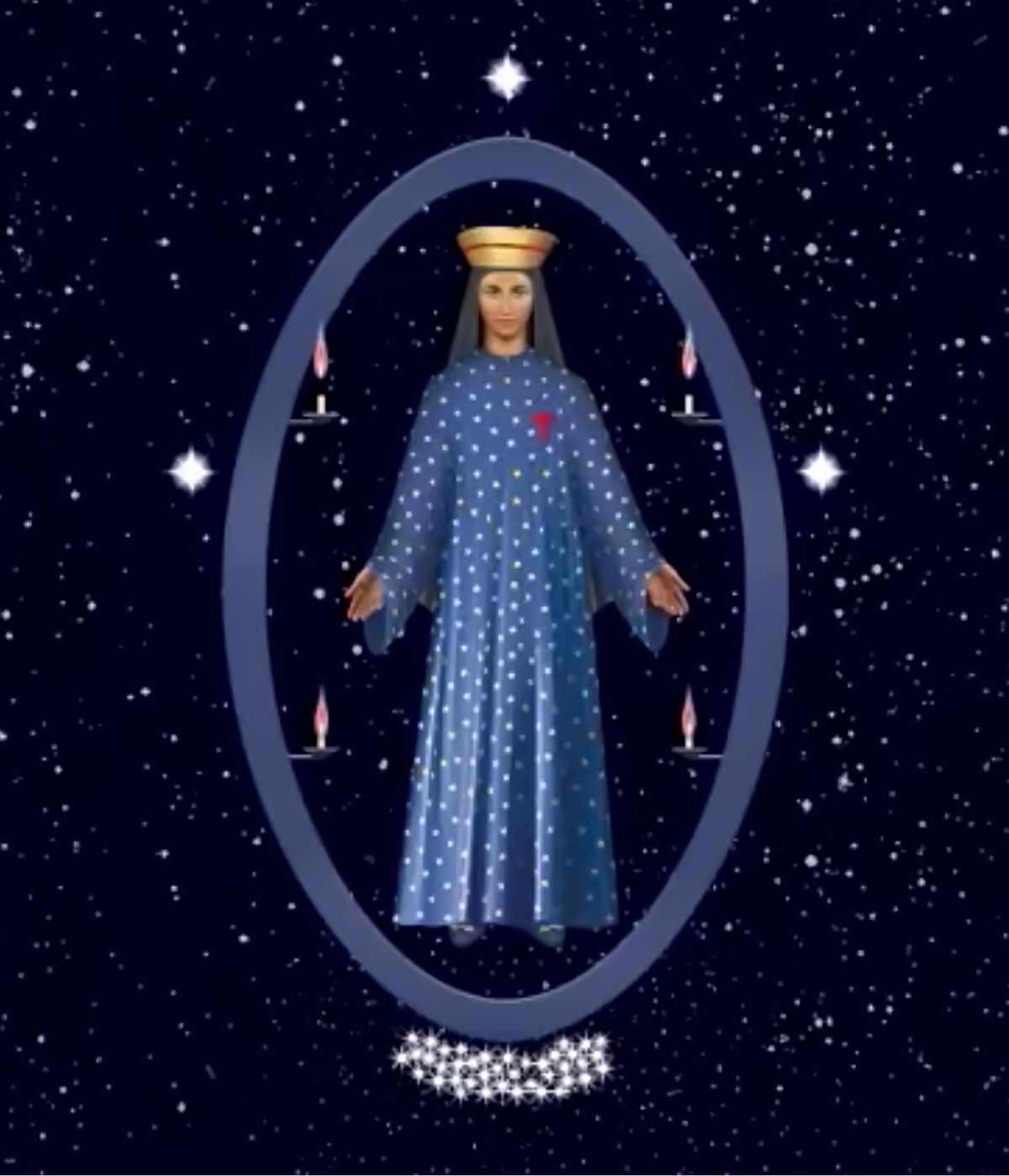
A silent appearance and at night
The second link with the end of times confirms what it is perceived. An extremely rare case, but not unique.
So Pontmain was an apparition:
1) Silent
2) At night
3) And in the sky
It is important to know the symbolism of the places and to relate them to the biblical symbolism. When Mary appears in a grotto at Lourdes or on a mountain at La Salette, she expresses the same notion: the grotto, the mountain, means isolation from the world.
When Jesus says, “When you see the abomination of desolation raised in a holy place, those who are in Judea flee to the mountains” (adding carefully: “the one who reads understand”). He does not refer to an escape, but to a resistance of the people of God before the world. Because when this is not governed by Christian principles, it belongs to Satan, and we call it Babylon.
“Get out of Babylon, my people!” is the alarmed cry of the Apocalypse, that tells us not to take part in abominations and in the perverse life of the world. In other words not to mix to it. In fact, “Pray and do penance” is the constant message of Lourdes and La Salette.
We note that at Fatima, Mary is like resting on a tree; that already announces the Garden of Eden, the heavenly Jerusalem, and then the resurrection of the Church indicated by the miracle of the sun.
At Pontmain we are not there yet, because if Our Lady appears at night, in the sky, and without speaking, it means that we are in the full of the tribulation, then in the darkness, and that she will be our only beacon, a light only apparently silent.
In La Salette, speaking of the apostles of the last times, She clearly says:
“I am with you and in you, provided that your faith is the light that illuminates these days of doom. Fight, children of light, few who can see, because now is the time of times, the end of ends.”
Then the light is faith, the guide is Maria, and including a little “rest”, the whole world is in the dark. For this reason She is silent, because She will draw near us spiritually, through faith. During the trials, the time of Her appearances will be over, everything will be at the inner level.
Another small detail: behind the Guidecoq house, there was a field (at the location of the present church), and She showed herself above it, as in Tilly.
Let’s look at the five phases of the apparition.
Phase 1 – Mary is the Bridge
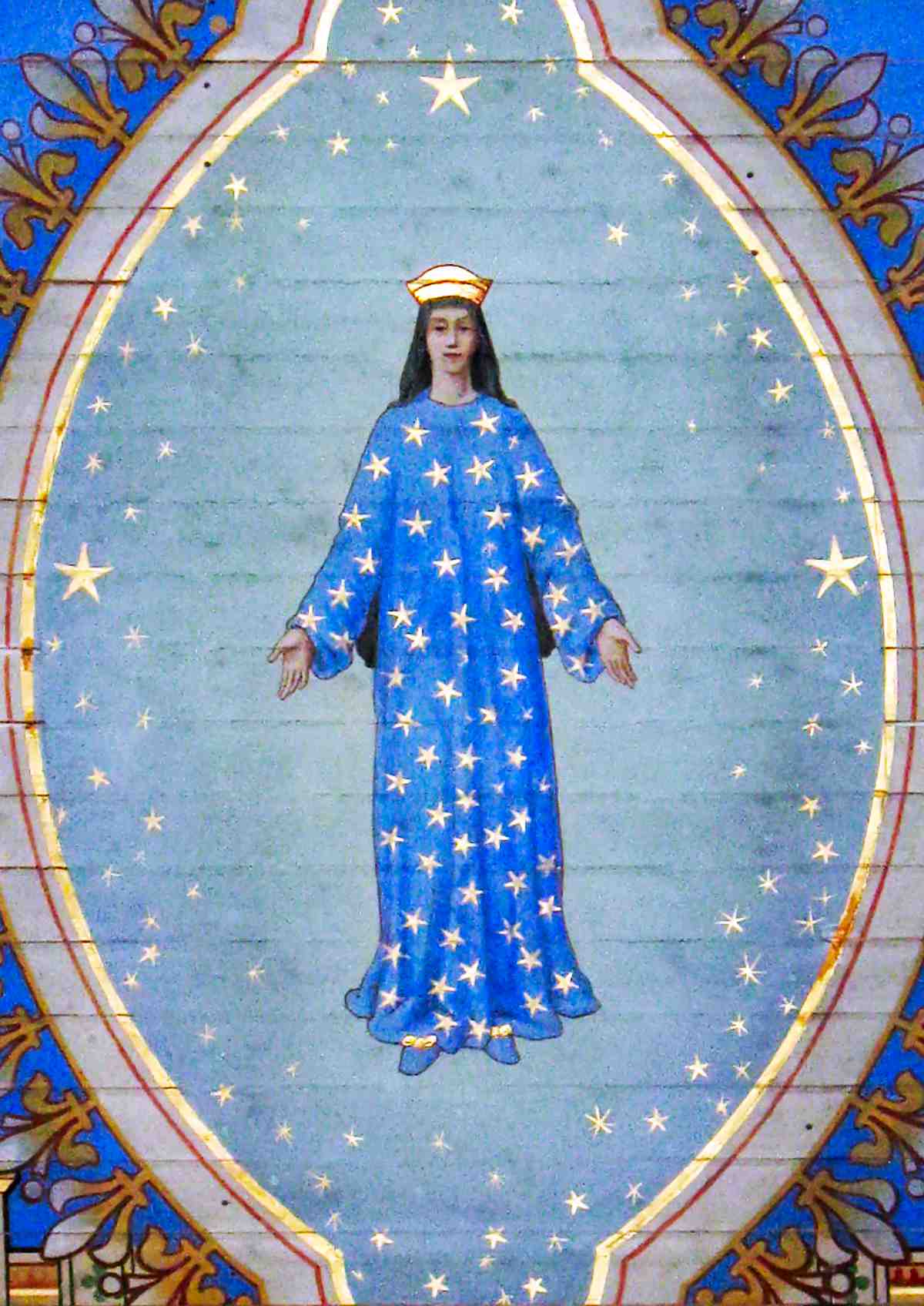
Maria act as a bridge between the beginning and the end of the Church
When She appears, she is alone in the sky. He wears a blue dress dotted with stars; has a black veil on her head that goes down to half the forehead (and seems to confirm what has just been said as a symbol of suffering and pain), and on this, a gold crown (the center surrounded by a thin red outline).
The stars, with five points, can be seen as a reference to the number 5, for example in the fingers of one hand (which by the way She will be moving together with the other one, to give rhythm to a song).
The village is called Pontmain (Bridge-hand), as if the message were: “I’m a bridge between two elements which value is 5”. This figure probably also refers to the final anguish of the Church, since it personifies the five wounds of Christ.
It can be said, therefore, that Pontmain represents the bridge of the last Passion of the Church, during which Mary watches over his people announcing and promising the return of His Son (the Parousia).
The Virgin Mary is at the center of 3 big stars: a clear reference to the divine Trinity, of which She is the Messenger.
Phase 2 – The Coded Message
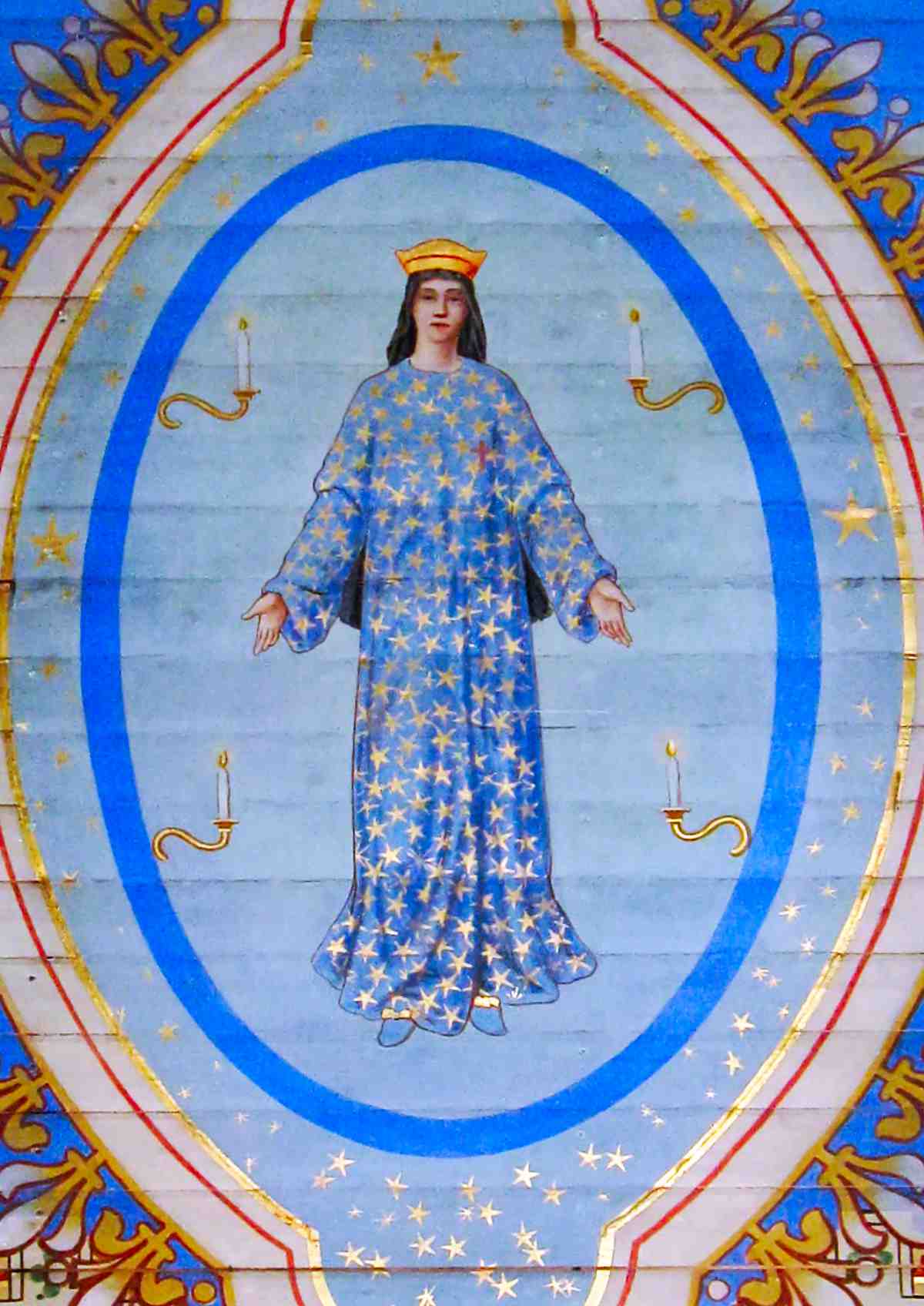
A code Message
The second phase is crucial for the understanding of the whole message and it begins with the arrival of the priest Guérin to the barn.
What happens at that moment?
1) The moment he arrives, a small red cross is quickly outlined on the heart of Mary.
2) With the same speed and at the same time a blue oval appears around the beautiful Lady, leaving outside the 3 mentioned stars, and within 4 holders with their unlit candles.
It is clear that the small red cross, formed at the arrival of the priest, symbolizes the Church, and its color reveals the future labor.
The same meaning emerges for the oval, from which it can be understood the following:
– That the Church enters into Her Passion (red cross)
– This is bounded in time (oval closed)
– That its duration will be based on four (4 candles)
– That the Trinity controls the operations (because the 3 stars are left out)
– That Heaven gives us the Holy Mother as the main support and guide during the distress (because She is inside the oval).
– That the Passion will take place in unfolding stages such as the apparition does.
Second part of phase 2 – The Writing Banner

BUT PRAY MY CHILDREN GOD WILL ANSWER SOON
MY SON LET HIMSELF BE MOVED
Here, the analysis does not take into consideration, for now, the content of the written text but its symbolic aspect which seems to contain an encrypted message.
1) It seems that the only instruction given is the prayer: “Mais priez” (But pray).
2) Maria get close to Her people but not to all: “mes enfants” (my children).
3) The “Mais” (initial word, ie “But”) is shown alone, for 10 minutes. Why?
Because it gives us a precise calendar of events, and therefore it is no longer the situation, since that moment, to doubt about the connection with the tribulations of the end times. The letters of “Mais” summed, (according to the French alphabet; ndt), form the number 42. (a = 1, b = 2 etc.).
Well, as it has been seen previously, 42 months are 3 and a half years, and correspond mainly to the life time of the “beast” of the Apocalypse.
Thus, the lonely persistence (for 10 minutes) of the first term “Mais” means: “What I have to tell you is in relation to the 42” or “begins with 42” and we know what this figure indicates, just read chapter 13 of the Book of Revelation concerning the period of the beast, the sixth trumpet.
Thus it would be explained, “the error” of the initial “But”, since it should only be utilized as continuation of another sentence (here missing) that justifies the meaning.
As a result, thanks to the 42, we now know that this “But” introduces the sixth period and implicitly refers to earlier times. We are in the middle of the three apocalyptic woes, rightly in the second one.
4) Finally, the statement is a promise full of hope: the prayers of Her children will be answered.
This providential “but” directs us not only to the period of time we are in, compared to the Apocalypse, but it suggests a sentence containing some indication of events, because through this written message, the Virgin reveals the unfolding of the tribulations and their key dates.
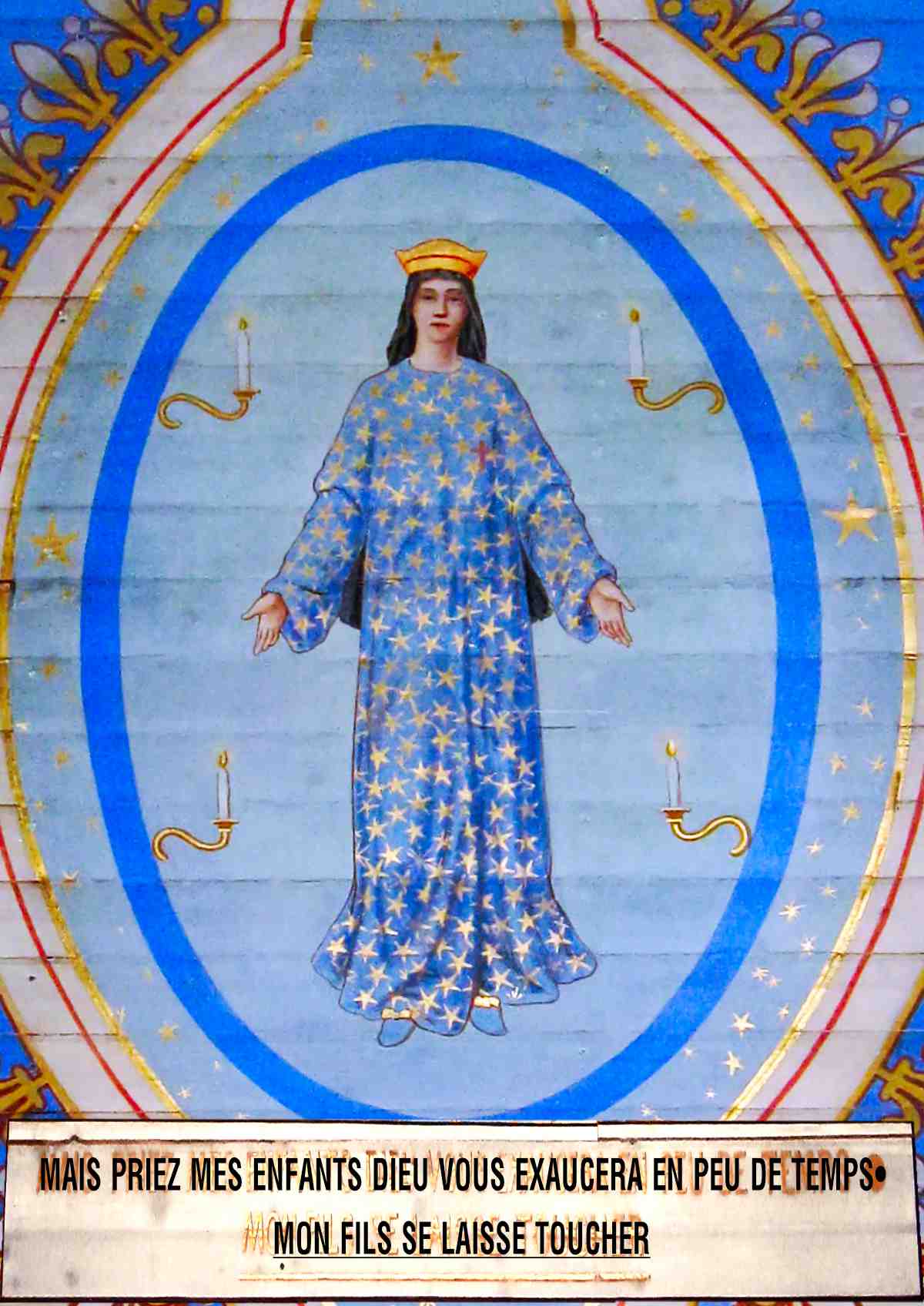
The second part of phase 2: the writing banner
The Message reveals at least two reading levels
a) An immediate meaning – the promise of a divine intervention in short-term – to the extent in which the people of God will get it through prayer; as it was the case of the armistice (between France and Prussia) that became effective few days later.
b) A code meaning, for a long-term interpretation, which is located in the very structure of the sentence:
In the first line: 47 points + 1 large golden dot.
In the second line: 22 letters + 1 underlined trait that emphasizes it totally.
Because the appearance took place in January 17, 1871, the calculation is simple:
1) 1871 (included, because we are at the beginning of the year) + 47 = 1917: Fatima.
We note that Fatima is fully symbolized in the 48th “character”: a big dot “like a golden sun of the same height of the letters” according to the saying of the seers. And the apparition of Fatima is famous for the miracle of the sun on October 13.
2) 1917 + 22 = 1939.
But, if you consider that the big dot has value of a letter, by having the same height of the other ones, as said previously above, the following counting follows:
1917 + 1 + 22 = 1940.
The first calculation gives the year of the declaration of war from France to Germany.
The second one, vice versa, refers to the invasion and occupation of France by the Germans; sad reminder of the 1870-1871 situation… but worse!
3) The undeline represents the totality of the second sentence, therefore, it can be considered to have the same value, namely 22 other typefaces! So we have:
In the first calculation – 1939 + 22 = 1961 – the year of the official convocation of the Second Vatican Council through the Bolla of Convocation “Humanae salutis” of Pope John XXIII on December 25, 1961.

Bolla of Convocation “Humanae Salutis” of Pope John XXIII
In the second calculation – 1940 + 22 = 1962 – the actual year of the same Council opened on October 11, 1962.
In the underlined sentence is contained, however, an information that does not appear explicitly and it needs to be extracted. It comes from the empty gaps equally highlighted by the long underline, and they are 4.
If normal spaces are only “white” and “empty”, therefore they cannot be calculated, those underlined possess an additional footprint that gives them a special value.
Therefore, adding them to the first counting, that is the year of the official convocation of the Council, you get the date of his conclusion:
1939 + 22 + 4 = 1965 (that is on December 8, 1965).
Here, therefore, the symbolic message of Pontmain in 3 key dates:
1) Fatima and the First World War
2) The Second World War
3) The Second Vatican Council rightly considered by Monsignor Lefebvre, similar to a third world war.
One last point:
The banner begins to form at praying the Magnificat, namely during a messianic hymn announcing the Divine Justice, rewarding the good and confusing the wicked.
The message continues to be appear gradually during the Litanies, the Inviolata and Salve Regina, that are the three prayers that put us under the protection of the Holy Virgin.
Phase 3 – Hope

After having transmitted this important writing, Maria insists on hope. The third phase is dedicated precisely to this virtue. Why?
1) The message on the banner remains on display for the entire period of the song “Mother of Hope.”
2) Mary accompanies the choir smiling and moving his fingers.
She thus highlights the importance of such a virtue, as She had already announced at La Salette. Hope that is contained in the same text of the Magnificat. That’s why the written banner began to make itself visible with that song.
The same text that Our Lady presented, five years later (even 5), in Her apparition of Pellevoisin, in continuity with that of Pontmain.
Phase 4 – The Passion of the Church

The fourth phase very clearly expresses the entrance into the most active and toughest of the tribulations, we will call it the Passion of the Church itself.
The banner that has just dissolved, and there is, therefore, at the end of the dates described above: those of 1962 or 1965, right after the Vatican Council II.
And what happens?
1) She falls back in sadness.
2) A bright red cross appears with a Christ of the same color but darker.
3) Above the Divine Crucified a wording appears with capital letters: JESUS CHRIST.
4) A star lit the four candles.
The bloodied Christ and red cross show without doubt the Passion of the Church entered, in fact, in the more crude age of Her persecution, after the Vatican Council II.
Where did the stricken look on Maria’s face come from that surpassed everything one can imagine? – You ask Joseph Barbedette.
When one knows what the Church has become in 50 years, its liturgy, faith, the apostasy and the plethora of lost souls and sent to hell, you can very well understand this immense expression of sadness.
The four lit candles indicate that this phase is based on a value of “4”
And it is certainly about the Church since She is always in the oval.
Jésus-Christ = 151
The name of Jesus Christ, written in full, is an eschatological indication that it can be interpreted this way.
Before the altar, we say “adiutorium nostrum in nomine Domini,” which means: “Our aid is in the name of the Lord.” Not uniquely in the Lord, but also in His name!
This name has a value of “151”, using the same method used for the “Mais” or “Ma” (that is counting and summing up the French alphabet; NDT), without doing any numerology.
Now, having Our Lady at La Salette in 1864 given the indicative starting point of the period of persecution (for the Church) in the broadest sense, that year added to 151 gives 2015. And this confirms that we are living, in full, the last extra time at our disposal.
Keep in mind also that this sentence is being formed during the singing of the “Parce Domine” which is particularly tailored to the tribulations:
“Parce Domine, parce populo tuo” (Forgive me Lord, forgive your people)
“It in aeternum irascaris nobis” (Do not get angry with us forever).
The correlation between the unfolding of the apparition and the songs (and what they mean) is very enlightening.
Phase 5 – The Sepulchre and the Two Witnesses
The priest ask the people to sing the Ave Maris Stella and instantly:
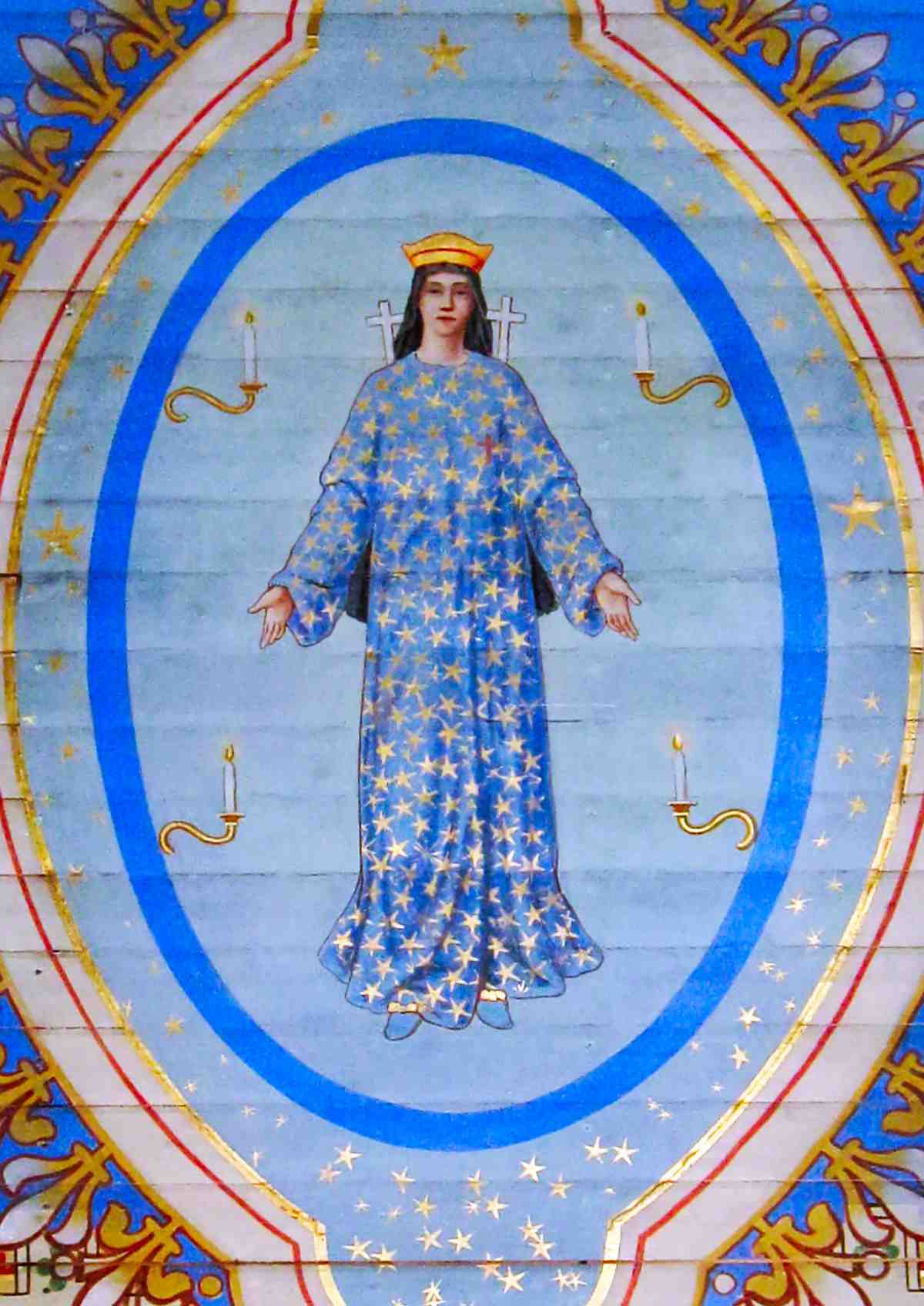
1) The red cross disappears.
2) The four candles stay lit.
3) Two small white crosses are placed on the shoulders of the Virgin.
4) She returns to smile but with a footprint of gravity, as if she remained a memory of Her previous sadness.
This, too, is very simple to understand: the crucifix disappears because the Church is in the sepulchre; this is the last phase of the Passion; that’s why the four candles are lit and the oval is always there.
And since the Church is in the sepulchre, there remain only the right, symbolized by the two white crosses that represent the two witnesses of the Apocalypse.
The latter are the emblem of the laity and the consecrated still faithful to the ancient doctrine (the loyalty so highly demanded by Jesus in the Gospel) guided only by faith and hope in this last period of deception and suffering.
In the previous stage, Maria was looking at the crucifix, while here again She has Her eyes turned toward on the visionaries, Her children, therefore the children of God, the righteous remained faithful, and described at La Salette as apostles of the last times.
And above all, the last song is that of the Ave Maris Stella, which explains the whole course of three years at the sepulchre, during which the Virgin Mary and the apostles of the last times will act to achieve what is contained in the song (Ave Maris Stella) itself. And it is natural that this is the last one, that contains everything!
The Latin text of the hymn as authorized for use in the Liturgy of the Hours of the Roman Rite (ordinary form) is the following:
Ave, maris stella,
Hail, star of the sea,
Dei mater alma,
Nurturing Mother of God,
atque semper virgo,
And ever Virgin
felix cœli porta.
Happy gate of Heaven.
Sumens illud «Ave»
Receiving that “Ave” hail
Gabrielis ore,
From the mouth of Gabriel,
funda nos in pace,
Establish us in peace,
mutans Evæ nomen.
Transforming the name of “Eva” Eve
Solve vincla reis,
Loosen the chains of the guilty,
profer lumen cæcis,
Send forth light to the blind,
mala nostra pelle,
Our evil do thou dispel,
bona cuncta posce.
Entreat (for us) all good things.
Monstra te esse matrem,
Show thyself to be a Mother:
sumat per te precem
Through thee may he receive prayer
qui pro nobis natus
Who, being born for us,
tulit esse tuus.
Undertook to be thine own.
Virgo singularis,
O unique Virgin,
inter omnes mitis,
Meek above all others,
nos culpis solutos
Make us, set free from (our) sins,
mites fac et castos.
Meek and chaste.
Vitam præsta puram,
Bestow a pure life,
iter para tutum,
Prepare a safe way:
ut videntes Jesum
That seeing Jesus,
semper collætemur.
We may ever rejoice.
Sit laus Deo Patri,
Praise be to God the Father,
summo Christo decus,
To the Most High Christ (be) glory,
Spiritui Sancto
To the Holy Spirit
tribus honor unus. Amen
(Be) honour, to the Three equally. Amen.
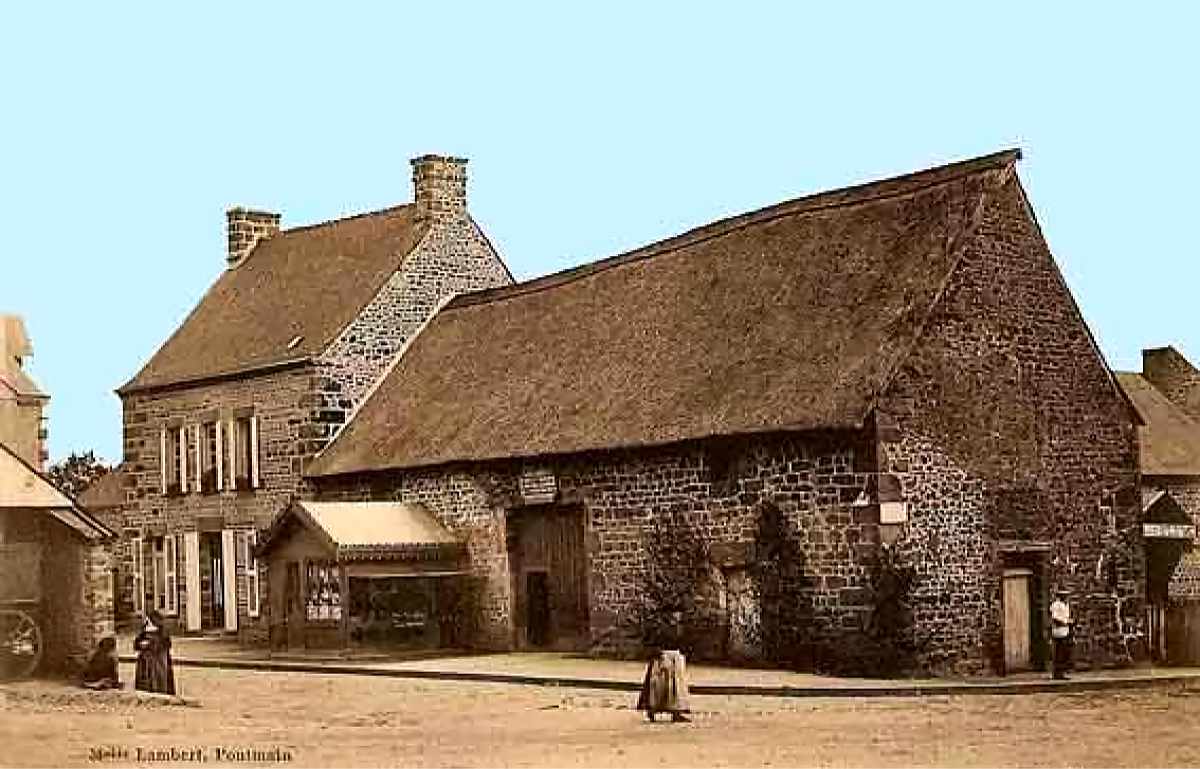
The barn Barbedette
Conclusion – The Ultimate Secret, the Birth
It was found that in the Pontmain Our Lady drew crowds to grant graces of holiness and repentance; physical healings were few so that the abbot Guérin, seeing so great a number of people returning to God, called her “Our Lady of Conversion.”
This is what it is all about at the end of time, when it is not the bodies that need to be healed, but the souls. Therefore, her official name is:
Our Lady of Hope of Pontmain
And speaking of hope, I will conclude with a small parallel on the concept of birth. Then why is the Virgin showing a large dress without belt and shoes that look like slippers?
Because this is the keeping of pregnant women, or rather, of the woman who has just given birth, but the beautiful Lady is not waiting, but rather in the privacy of Her own home, as it is in time of pregnancy, about 40 days after birth, well symbolized by the 40 days of fasting in the desert or the 40 years prior the entering of the Promised Land.
This is the reason of Her long stay beyond (3½ hours) so that the purification of the children of God was concluded through the great tribulation.
What kind of birth is mentioned in these apocalyptic times? It is about that Christian humanity that Jesus, after He left the Earth, wanted to be carried on by His Church.
The Church itself, for that matter, would pass through the same stages of the formation of a man: conception, birth, childhood, maturity and decline; just like the image of Her Divine Master, whose life, passion, death, burial, resurrection or re-birth are the emblem of the similar Resurrection of the Church, the future heavenly Jerusalem.
Our Lord too, uses several times the concept of labor and birth.
The actual duration of a pregnancy is 38 weeks or 266 days between ovulation and birth. At the end of this period the childbirth comes.
So: time = 38 weeks of pregnancy = 266 days; birth at the 39th week.
Conclusion:
– The Christ has been raised between the 38th and 39th hours.
– At Pontmain, 38 men had gone off to war and they are all returned.
– The department of La Salette bears the number 38.
– The paralytic of Bethesda was sick for 38 years.
– May 13 2016 will use, surprisingly, the 38th month of the pontificate of Francis, (that may mark the entrance of mankind in the tribulation times), and it will be the day when the apparition of Fatima will enter its 100th year (with
the end of one hundred years allowed to Satan; NDT), and the Pope will enter its 39th month of investiture.
It is therefore all very clear: Pope Francis is the last pope of a complete cycle of the Petrine Church told in Revelation that ends with the birth of a New Church Called the Heavenly Jerusalem.
The Re-birth of the Church is, therefore, announced May 13, 2016, the date from which will trigger the recent events required for its resurrection: the fall of Babylon, the punishment of the wicked and the final purification of God’s children.
It is therefore possible and very probable that from that moment on, several events will unfold as heralds of the “Dies Irae” (or Day of Wrath).
With this it is already three years that I am warning tirelessly my contemporaries. But they smile and continue to believe in lies and human solutions. However, one day the invisible will become visible and at that time there will be no forgiveness possible for anyone.
It is necessary to prepare before, to render terse our souls, by rejecting our sins and combat them.
In the book of Jonah, the city of Nineveh was spared because the totality of its inhabitants did penance for 40 days.
The Babylon of today, despite the alarm cry of the apostles of the last days, does not want to change her mind, they rely on messages and warnings from heaven that come from all over in large number.
For this reason, Babylon the great will not be spared; her 40 days are about to run out and it will eventually fall into shame unexpectedly and suddenly.
The one who has ears intend what the Spirit says to the churches (the phrase repeated 7 times, at the end of each church described in Revelation Chapters 2 and 3).
Clarification
This article is the text of my conference given in Tilly-sur-Seulles on April 23, 2016. The interpretation of the Pontmain apparition is personal to me, except for the passage concerning the coded message (the 3 periods from 1871 to 1965), which is the result of a collective work, a discovery made with my friends of the Pontmain group, directed by Chouan de cœur, which meets every 17th of the month in Pontmain to ask Our Lady for the return of the King.
Author – Louis D’Alencourt